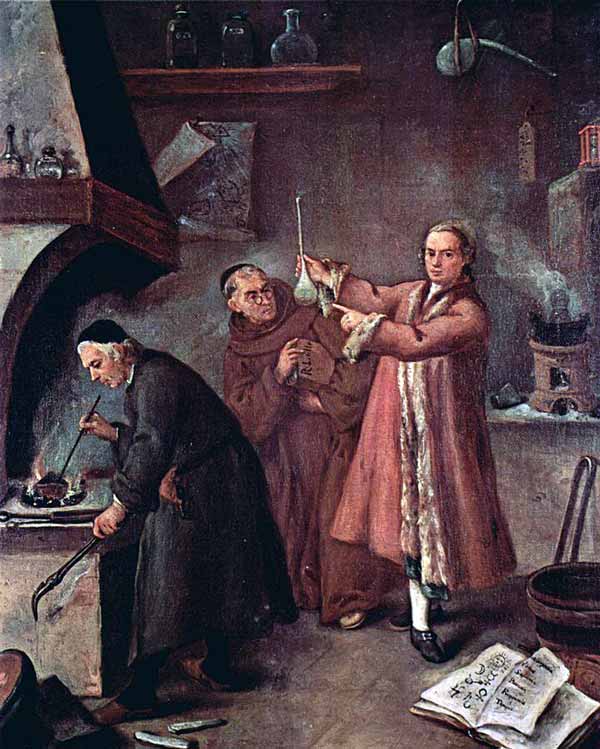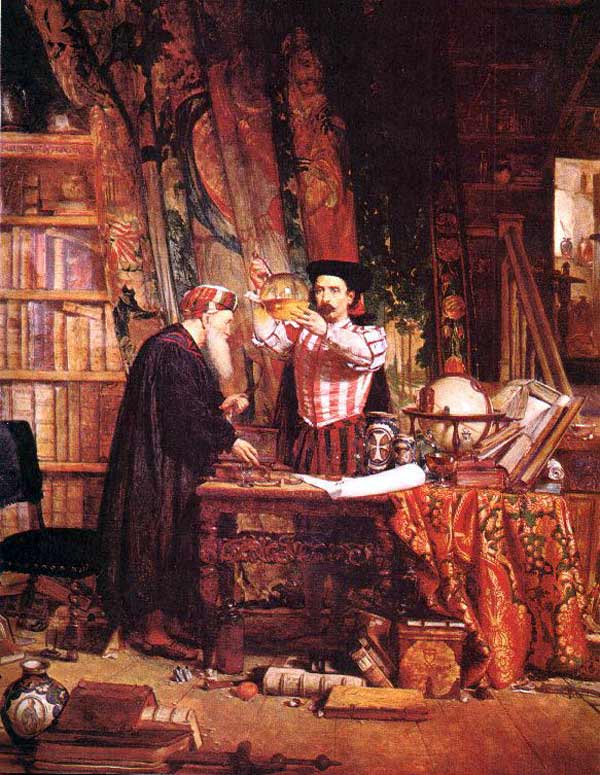
Virgil Wong, Alchemy, digital composite printed on metal
The relationship between Mythology and the Religious traditions is an intricate weaving of metaphor. Both Mythology and Religion have the similar function
of relating lived experience to a universal purpose. Often, religion relates life choices to divine models, while Mythology creates narratives that
contextualize experience. In many instances mythology and religion function simultaneously. However, a major distinction between the two traditions is that
mythology is defined as an adaptive narration, and dogmatic perspective restricts religion to a lived mythic model. Though there is a wide continuum of
religious interpretation ranging from orthodox to eclectic, as a lived mythology, religion is a lens that the world is seen through. To clarify, there is a
specified Catholic religious lens that filters mythology to fit a defined vision of the universe. Many mythologies have foundations in cultures that are no
longer active, such as in the Greek and Roman myths. These mythologies resonate throughout history and reveal archetypal characterization that may be seen
throughout the world’s cultures and religions. A specific example of the relationship between myth and religion is better understood through the mythology
surrounding the Alchemical Tradition as explored by the theorists, Mircea Eliade and Carl Jung.
A working understanding of Alchemy includes both scientific method and spiritual symbolism. A series of elemental transformations is intended to create a
new material. However, these changes are not just dependent on following a physical recipe, they must also incorporate symbolic relationships. The basic
alchemical sequence begins with a male and female sealing the prima materia (original substance) into a vessel. This process changes the substance
from being red to back, nigredo, the dark side. Calcinatio, is the application of fire to the substance, turning it from black to purple
and then into ash. The ashes are dissolved in the solutio, or water. The sunlike substance, sulfur accomplishes the coagulatio, drying,
of the solution. The pairing of opposites is possible in a gaseous state, sublimatio. Finally, an alchemical wedding of process and material leads
to the reddish yellow/rosy pink philosopher’s stone, coniunctio. Details of this process are revealed by reviewing alchemical symbolism and
writings throughout thousands of years of history. The residue of the alchemical tradition is found in science, mythology, religion, art, literature,
psychology, politics, and many more areas of intellectual thought and cultural experience.

Anbig by Jacopo, Alembic from 13th century Tabriz, Iran
Mircea Eliade and Carl Jung are two twentieth century theorists who explore the implications of alchemy in a modern context. Each theorist has a working
definition of mythology that reveals how the study of alchemy is an important mythological structure. The challenge that both writers have in defining myth
is that it is the nature of myth to transform boundaries. In Myth and Reality, Eliade attempts a definition: “Myth narrates a sacred history; it
relates an event that took place in primordial Time, […] it relates how something was produced, began to be” (5-6). This definition focuses on the
method of mythology. He emphasizes that myth is based on creation stories, which are connected to what is sacred in a culture. In Alchemical Studies Carl Jung is less explicit with his definition of mythology. “Even though mythology may not be ‘true’ in the sense that a
mathematical law or a physical experiment is true, it is still a serious subject for research and contains quite as many truths as a natural science; only,
they lie on a different plane. One can be perfectly scientific about mythology, for it is just as good a natural product as plants, animas or chemical
elements” (159). Jung states that both myth and science reveal truths, however mythic are understood in a different method than scientific truths. He also
states that both myths and the elemental world are naturally occurring. While both Eliade and Jung agree that myths are an integral part of human
perspective, Eliade focuses on myths as reflecting the sacred in narrative synthesis, while Jung emphasizes mythology as a process similar to other natural
phenomena.

L'alchimista by Pietro Longhi
In The Forge and the Crucible: The Origins and Structures of Alchemy, Eliade explores how alchemy connects the physical and the sacred through a
variety of cultural contexts. Beginning with “Meteorites and Metallurgy”, Eliade states, “It was inevitable that meteorites should inspire awe.
They came from some remote region high up in the heavens and possessed a sacred quality enjoyed only by things celestial”(19). He continues to explain how
the exploration of metallurgy was connected to a spiritual understanding of the universe, emphasizing that in many cultures smiths, or metal workers, held
an elevated status in a community. In a later chapter, “The World Sexualized”, Eliade refers to the union of metals in the alchemical marriage as
a continuation of natural processes. He clarifies that plants, metals, ores, and stones were given gender forms by cultures in the ancient Orient,
Mesopotamia, amongst others. The tools, individuals, and processes that engage these metals are all critical components of the Alchemical Tradition. Eliade
establishes a clear connection between the production of metals and the sacred significance throughout his book.
In contrast, Jung articulates alchemy as a metaphor for psychological functions. Alchemy is symbolic of figurative functions within the psyche as revealed
by a variety of myths found in visions, myths and symbols. Jung states that “The alchemist […] dreams in his own specific language”, and that “We have [to]
learn the psychological secrets of alchemy” (69). He hypothesizes that “the symbolism of alchemy has a great deal to do with the structure of the
unconscious” thereby implying that by attempting to wed alchemy with depth psychology we can begin to decipher both mysteries (69). In the chapter “The
Philosopher’s Tree”, Jung states,

William Fettes Douglas, The Alchemist
[T]he confrontation with the unconscious usually begins in the realm of the personal unconscious, that is, of personally acquired contents which constitute
the shadow, and from there leads to archetypal symbols which represent the collective unconscious. The aim of the confrontation it to abolish the
dissociation. (348)
In relation to this statement, alchemy is represented in two functions. As a tradition, Alchemy is a part of the collective unconscious and reflects
archetypal symbols in a way that reveals psychic functions. However, Alchemy also functions as a personal journey of confrontation and dissociation. The
alchemist separates from the collective to undergo a series of psychic processes in an attempt to separate, engage, and pursue the nature of the
philosopher’s stone. Jung argues for both processes through multiple mythological and symbolic examples in a variety of writings.

by Carlos Caban
As a tradition, the role of alchemy may be observed from several perspectives. Eliade argues for the connection of physical phenomenon to the sacred, while
Jung creates a metaphorical connection between the symbolic functioning of archetypes in the collective unconscious and individual psychology. While Eliade
and Jung enter into an understanding of Alchemy with different strategies and goals, they both argue for the importance of alchemy in the generating of
myth throughout global communities. Both theorists articulate their understanding through cultural, religious, and mythical examples. Just as the
scientific process draws on alchemy to explore chemical interactions, so does the intellectual mind rely on the symbolic experience of alchemy in the
generation of an active understanding of individual and cultural systems.